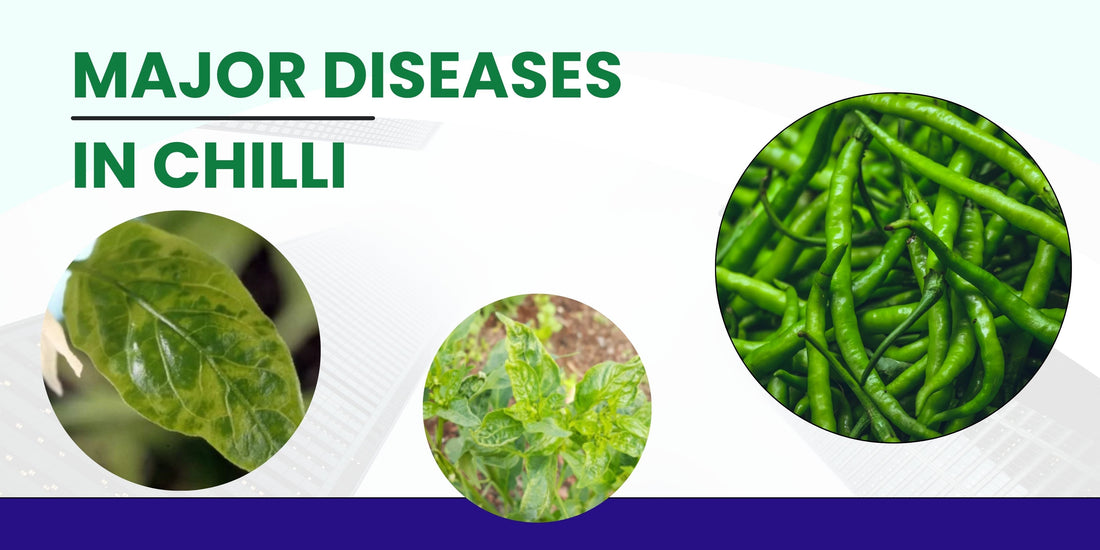
MAJOR DISEASES IN CHILLI CROPS
INTRODUCTION:
Chilli is an excellent source of vitamin A and C besides its pungent and medicinal uses. It is vulnerable to various fungal, bacterial and viral diseases which hampered its production and productivity. The present topic will give details about the Major chilli disease symptoms, epidemiology and management practices.
List of Diseases in Chilli Crops:
- Viral Diseases (Chilli Leaf Curl Disease, Mosaic virus).
- Die Back/ Anthracnose
- Fusarium wilt
- Powdery mildew
- Bacterial wilt
- Cercospora leaf spot
- Phytophthora leaf blight &fruit rot
- Bacterial leaf spot
- Mosaic Virus
1. Viral Diseases:
Chilli Leaf curl

Causal organism: Tobacco leaf curl bigeminivirus
Symptoms
Leaf curling and subsequent size loss are the disease's outward manifestations.
Plants that are afflicted develop pale yellow leaves. The diseased plant seems to be a witches' broom, the internodes shorten, and the badly affected plants continue to be stunted. In vulnerable cultivars, fruit development is crude and deformed.
Transmission
The leaf curl virus is spread by whiteflies (Bemisiatabaci) and perennates on a range of annual and perennial hosts in nature.
Whitefly feed on the plants sap which is why they tend to attack the fresh young growth on plants. Left unchecked they will multiply rapidly and cause lasting damage to the host plants, often stunting their development.
The whitely also secrete a sticky residue on the plants which then attracts dust and muck and usually causes problems with fungal growths on the leaves.
Mosaic Virus

Causal organism: Tobamo, cucumoviruses and potyviruses.
Symptoms
The induction of symptoms in chilies varies with respect to the virus associated with the disease. Potato virus Y and its strains generally induce vein banding followed by necrosis of the veins, petioles and stems of chillies.
Pepper veinal mottle virus causes mosaic mottling, distortion and filliformy of leaves with bushy appearance of the infected plants.
Pepper severe mosaic produced mosaic mottle, vein clearing and deformation of the infected leaves.
Tobacco etch virus syndrome includes dark green vein banding, cupping, laminal necrosis of leaves. Cucumber mosaic virus causes mosaic mottling, reduction of leaf lamina and distortion of leaves.
Transmission
All mosaic causing viruses are easily sap transmissible. The members and strains of cucumoviruses and potyviruses are mostly transmitted through aphid vectors Myzuspersicae, Aphis craccivora, Aphis gossypii, Rhopalosiphummaydis in a non persistent manner.
Epidemiology
Epidemiology of the mosaic diseases of chilies depends upon the activity and population of the vector in an area. Temperature affects both virus multiplication as well as buildup of the vector population.
Disease Management of viral diseases.
- The infected plants should be uprooted and burnt or buried to avoid further infection.
- Avoid monoculture of chilli crop.
- Raise at least two rows of barrier crops such as maize, sorghum or Pearl millet around your fields .
- Nursery beds should be covered with nylon net or straw to protect the seedlings from viral infection.
- Selection of healthy and diseased - free seed.
- Apply Carbofuran 3G @ 4-5 Kg/acre in the main field to control sucking complex and insect vectors.
2. Die Back/ Anthracnose

Causal organism: Colletotrichum capsici
Symptoms
As the fungus causes necrosis of tender twigs from the tip backwards the disease is called die-back. Infection usually begins when the crop is in flower.
Flowers drop and dry up. There is profuse shedding of flowers. The flower stalk shrivels and dries up.
This drying up spreads from the flower stalks to the stem and subsequently causes dieback of the branches and stem and the branches wither. Partia1ly affected plants bear fruits which are few and of low quality.
Epidemiology
The pathogen overwinters in agricultural waste, tainted seeds, and fruits. The disease thrives under cloudy sky, heavy rain, and moisture.
Disease Management
Use of diseased-free seeds can prevent the disease.
Eliminating the seed-borne inoculum is found to be possible when seeds are treated with Thiram or Captan 4g/kg.
3. Fusarium wilt
Causal organism: Fusarium oxysporum f.sp.capsici
Symptoms
Fusarium wilt is characterized by the plant wilting and the leaves rolling inward and upward.
The leaves die and turn yellow. usually manifest as confined regions of the field where a significant proportion of the plants wither and die, while sporadic wilted plants can also happen.
By the time symptoms appear above ground, the plant's vascular system is discolored, especially in the roots and lower stem.
Epidemiology
Disease development is favored by high temperatures and moist soil conditions, and it is worse in poorly drained soils. The ideal conditions for the organism's growth and sporulation are 20–300C and pH 5–8.
Disease Management
- Grow resistant varieties
- Avoid use of high nitrogen fertilizers and use a slow release organic fertilizers.
- Remove the weeds as many weed species host the disease Pathogen.
- If the disease persists, remove the entire plant and solarize the soil before planting again. To solarize the soil, spread a clear plastic trap on the soil surface for 4-6 weeks during the hottest part of the year.
4. Powdery mildew

Causal organism: Leveillula taurica
Symptoms:
First disease symptoms are noticed on the older leaves which progress to younger leaves.
The infected leaf is covered with white to grey powdery masses of the fungus where lower leaf surface also turn necrotic.
Heavy infection leads to leaf shedding resulting in heavy losses in yield.
Epidemiology
Cultivated and wild hosts such as Cynaracardunculus, Cicerarietinum, Lucerne, Oxalis cernaare the source of the pathogen during the off season. The optimum temperature fordisease development is 200C. Temperature above 300C appears to be lethal for the fungus.
Disease Management
Grow resistant varieties.
Spray with wettable Sulphur@0.25% or Dinocap@ 0.05%2-3 times at 10 -15 days interval
5. Bacterial wilt
Causal organism: Ralstonia solanacearum
Symptoms
The disease appears in the field as well as nurseries in scattered pattern on in patches.Initially, slight wilting of lower leaves in older plant is noticed.
In young seedlings the upper leaves show the wilting symptoms first. With the progress of the disease the initial wilt is succeeded by sudden and permanent wilt of the entire plant, with a slight or no leaf yellowing.
Infected young plants die rapidly whereas older plants may first show leaf dropping and discoloration or one side wilting or stunting and permanent death of the plant.
Epidemiology
The pathogen has a very wide host range and can survive in the soil for long periods.Secondary spread of bacterium occurs by irrigation water, infected soil, and diseased seedlings. The bacteria are able to produce and cause infection over a wide range of temperature i.e. 15 to 300C.
Disease Management
The disease can be reduced by cultural techniques include crop rotation with non-host crops, adequate drainage, heavy nitrogenous fertilizer use, choosing healthy seedlings, and preventing root damage.
Soil amendment with lime @8-10t per hec.
6. Bacterial leaf spot
Causal organism: Xanthomonas campestris pv.vesicatoria
Symptoms
The leaves exhibit small circular or irregular, dark brown on black-greasy spots. As the spots enlarge in size, the centre becomes lighter surrounded by a dark band of tissue. Many spots coalesce to form irregular lesions.
Severely affected leaves become chlorotic and fall off.Petioles and stems are also affected. On the fruits, raised water soaked spots with a pale yellow border are produced.
The spots turn brown developing a depression in the centre where in shining droplets of Bacterial cozen may be observed.
Disease Management
Cultural practices such as crop rotation 3-4 years with non-host crop.
Field sanitation is important. Also seeds must be obtained from disease free plants.
FAQ’s:
1. Which diseases are most common in chilli plants?
Powdery mildew, anthracnose, leaf curl virus, bacterial wilt, and damping-off are among the common diseases that affect chillies.
2. How can chilli crops show signs of powdery mildew?
The symptoms of powdery mildew include leaf curling, leaf drop, yellowing, and a white, powdery covering on leaves. Fruits with severe infections may be smaller and malformed.
3. What is chilli leaf curl disease, and what causes it?
Leaf curl disease in chilli is usually caused by viruses spread by whiteflies. Symptoms include curled, thickened leaves, stunted growth, and reduced flowering and fruiting.
4. What is bacterial wilt, and how can I identify it?
Bacterial wilt causes plants to wilt suddenly without yellowing, often affecting a whole branch or plant. Cutting the stem of an affected plant may reveal a brownish, slimy ooze.
5. How does anthracnose affect chilli plants, and what are its symptoms?
Anthracnose causes black or dark sunken spots on chilli fruits and stems, which may crack. It can lead to fruit rotting and reduced yield, especially in humid conditions.
Conclusion
The major diseases of chilli are leaf curl, anthracnose, powdery mildew, phytophthora leaf blight ,wilt (fungal and bacterial), bacterial leaf spot, cercospora leaf spot ,virus diseases, wheas other diseases are minor significance.Timely application of control measures such as application of fungicides can minimise the foliar diseases. Soil borne diseases can be reduced by crop rotation, growing resistant varieties and also application of bio-control agents.
